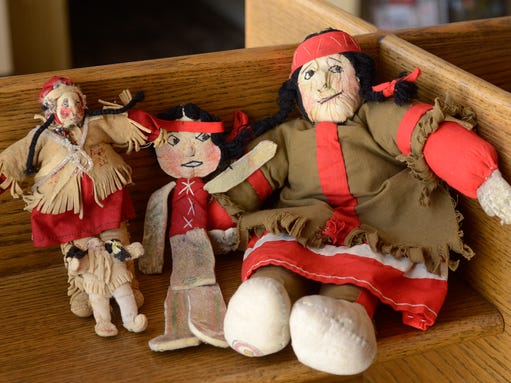
Artifacts left over from the Hiawatha Insane Asylum for Indians in Canton, now at the Canton Public Library.
In Tuam, in Galway, Ireland, the Bon Secours sisters ran a place for “fallen women”, from 1925 to 1961. People called it The Home. In Canton, South Dakota, in the United States, the federal government ran the only `asylum’ for Native Americans, from the dawn of 1903 to Christmas 1933, the Hiawatha Asylum for Insane Indians. The home and the asylum form parts of a shared history.
Thanks to the work of historian Catherine Corless, the world “learned” last week that close to 800 infants and children born in the Home were disposed of in a septic tank. These were children of single women. The women came and quickly left, moving to other parts of Ireland or beyond. The children stayed, to be persecuted in school and worse. They suffered extraordinarily high mortality rates. And then they were dumped in a septic tank.
While shock and dismay have been expressed, all of this happened in plain sight. Neighbors complained about the Home. Not so much about the abuse and disappearance of children, but about the stench emanating from the cesspool behind it. Thirty-five years is a long time in a small village to keep a large secret. There was no secret.
Canton presents a similar story. In the late 1890s, a senator from South Dakota began lobbying for an asylum for Indians because, he claimed, “insanity was on the rise among Indians.” Despite overwhelming opposition from the medical community, who found no evidence of high levels of mental illness among Aboriginal populations, the project went through, and, of course, ended up in the southwest corner of the senator’s state.
The vast majority of `residents’ of the Canton Asylum were in for resistance of one form or another. Canton residents and the few survivors of the asylum all agree that there were very few residents who manifested actual mental illness. If a Native American said no to a White person or to an agency or pretty much to anyone, it often meant going to Canton, where most died. Not surprisingly, given that for the first eight years, it had no psychiatrist on staff and for the first 25 of its 31-year history, it had no nurses. The Hiawatha Asylum was a death sentence.
Those who died were buried in an unmarked grave that now sits between the fourth and fifth fairway of the Hiawatha Golf Course. For the past few years, every year the Keepers of the Canton Native Asylum Story have come to perform a healing ritual. They also want the gravesite to be honored. They talk of not only honoring the dead but also of engaging in restorative justice.
From Tuam to Canton, people are engaging in restoration and in restorative justice. This means turning the camera away from the ones thrown into the earth like so much trash and focusing on those who threw those bodies into ground. Who throws dead children into septic tanks? Who throws Indigenous infants, children, men, and women into an unmarked grave? Who? Everyone. This is the process of `nation building’, and it’s a filthy process in which some bodies have value and others have less than none, are deemed problems and obstacles to progress and end up in trash heaps, septic tanks, unmarked graves. There was and there is no secret here.

Tuam
(Photo Credit 1: Elisha Page / Argus Leader) (Photo Credit 2: CNN)